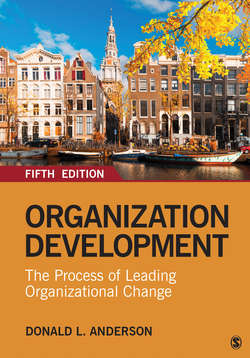Читать книгу Organization Development - Donald L. Anderson - Страница 65
На сайте Литреса книга снята с продажи.
Levels and Characteristics of Organizational Change
ОглавлениеWhen we talk about organizational change, we are referring to many different kinds of changes that occur at many levels. Changes can occur at the individual level when people learn new skills or develop new ways of working through mentoring, coaching, or education and training. Changes can occur at the group or team level as teams develop new ways of working with one another, define their goals and objectives, and learn ways of addressing conflict. Groups can also learn how to work more effectively with other groups (intergroup change) to solve problems or address interdependencies. Changes occur at the organizational level through the development of new strategies and processes, visions for a new desired future, and major system practices that affect all organizational members. Changes can also occur at suprasystem levels, where multiple organizations are implicated. These can involve changes, for example, between multiple organizations (such as mergers and acquisitions); between organizations and government agencies; or between cities, states, or nations.
Practitioners and scholars have noticed that organizational changes differ on a number of dimensions. Changes vary in several ways:
1. Planning. Organizational change can be planned or unplanned. Organizational members can be conscious and intentional about the changes that they want to make, often due to environmental factors, strategic or market needs, or other influences. Changes can also be unplanned, perhaps in response to an immediate threat or crisis. Weick (2000) contrasts planned changes with emergent changes, which are the “ongoing accommodations, adaptations, and alterations that produce fundamental change without a priori intentions to do so” (p. 237). Organization development as a field has primarily been concerned with the successful implementation of planned organizational change (Beckhard, 1969) or intentional change programs developed intentionally to improve the organization or address a deficiency.
2. Magnitude. OD literature differentiates between first-order and second-order change (Watzlawick, Weakland, & Fisch, 1974). First-order change consists of “incremental modifications that make sense within an established framework or method of operating,” and second-order change is defined as transformational changes that “are modifications in the frameworks themselves” (Bartunek & Moch, 1987, p. 484). First-order changes tend to be alterations or changes to existing practices rather than a rethinking or reinvention of the practice. Implementation of a computer system that simply automates existing work practices is an example of first-order change, where existing work practices are modified within the existing understanding of how the work is done, maintaining its current purposes, objectives, and processes. First-order change reflects an evolution of existing definitions rather than a revolution or redefinition. Rethinking how the entire organization used the computer system, including redefining roles, processes, values, and implicit meanings, would be considered second-order change. Because second-order change tends to reflect a more substantial shift, some refer to this type of change as “organizational transformation” (Bartunek & Louis, 1988). Chapman (2002) writes that, historically, most OD models reflect concerns with first-order change rather than second-order change. Others refer to differences in magnitude of organizational change by the labels transactional or transformational (Burke & Litwin, 1992), evolutionary or revolutionary (Burke, 2002), and incremental or transformational (Kindler, 1979).
3. Continuity. Weick and Quinn (1999) distinguish between episodic and continuous change. Episodic change is defined as distinct periods of change, usually infrequent and explicitly defined. When seen in this way, episodic change is usually framed as a response to a stable condition in which adverse conditions are present that force a change. Continuous change, on the other hand, reflects the idea that the organization is never truly out of a state of change, and that even in minute ways, change is always occurring.
